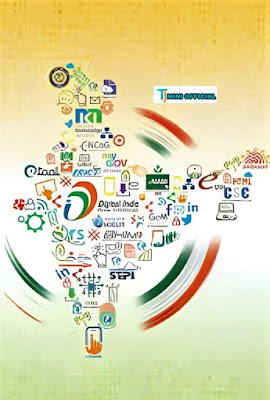Digital India, launched on 1 July 2015 by Shri. Narendra Modi, is an ambitious initiative by the Government of India to digitally empower the nation in the field of technology. The Digital India Corporation, established by the Ministry of Electronics and Information Technology (MeitY), plays a crucial role in innovating, developing, and implementing ICT and other emerging technologies for the benefit of the common man.
The primary goal of Digital India Corporation is to promote e-Governance and facilitate the realization of Digital India Programme's objectives. It provides strategic support to Ministries and Departments at both the Central and State levels for capacity building in e-Governance projects, encourages Public-Private Partnerships (PPP), nurtures innovation, and fosters technology in various domains.
A revitalized 'Digital India' program is expected to play a significant role in achieving India's aim of becoming a $5 trillion economy. One of the most successful outcomes of this initiative has been the Jandhan - Aadhaar - Mobile initiative, which has provided digital identification to over 1 billion Indian citizens.
In recent years, digital technology has played a vital role in accelerating India's economic growth, promoting social and economic equity, and overcoming infrastructure deficits. It has the potential to create a fair and equitable society and propel India to the forefront of nations, particularly by leveraging the energy and innovation of its young population.
Digital India comprises three core components: the establishment of digital infrastructure with digital centers for every resident, delivery of services digitally through e-Governance, and digital literacy to empower people. The initiative envisions various services such as digital locker, e-education, e-health, e-sign, and a national scholarship portal.
However, despite its merits, the Digital India Mission faces several challenges and drawbacks. Some of these include slow internet speed and limited Wi-Fi hotspots compared to more advanced nations, difficulties for small and medium-scale industries in adopting modern technology, limitations of entry-level smartphones for internet access, a shortage of skilled manpower in the digital technology field, and the need for around one million cybersecurity experts to combat the growing threat of digital crimes. Additionally, there is a lack of sufficient user education to ensure the program's success.
Addressing these challenges will be essential to fully realize the potential benefits of the Digital India initiative and accelerate the country's progress in the digital age.
The primary goal of Digital India Corporation is to promote e-Governance and facilitate the realization of Digital India Programme's objectives. It provides strategic support to Ministries and Departments at both the Central and State levels for capacity building in e-Governance projects, encourages Public-Private Partnerships (PPP), nurtures innovation, and fosters technology in various domains.
A revitalized 'Digital India' program is expected to play a significant role in achieving India's aim of becoming a $5 trillion economy. One of the most successful outcomes of this initiative has been the Jandhan - Aadhaar - Mobile initiative, which has provided digital identification to over 1 billion Indian citizens.
In recent years, digital technology has played a vital role in accelerating India's economic growth, promoting social and economic equity, and overcoming infrastructure deficits. It has the potential to create a fair and equitable society and propel India to the forefront of nations, particularly by leveraging the energy and innovation of its young population.
Digital India comprises three core components: the establishment of digital infrastructure with digital centers for every resident, delivery of services digitally through e-Governance, and digital literacy to empower people. The initiative envisions various services such as digital locker, e-education, e-health, e-sign, and a national scholarship portal.
However, despite its merits, the Digital India Mission faces several challenges and drawbacks. Some of these include slow internet speed and limited Wi-Fi hotspots compared to more advanced nations, difficulties for small and medium-scale industries in adopting modern technology, limitations of entry-level smartphones for internet access, a shortage of skilled manpower in the digital technology field, and the need for around one million cybersecurity experts to combat the growing threat of digital crimes. Additionally, there is a lack of sufficient user education to ensure the program's success.
Addressing these challenges will be essential to fully realize the potential benefits of the Digital India initiative and accelerate the country's progress in the digital age.
Tags:
English WriteUps

